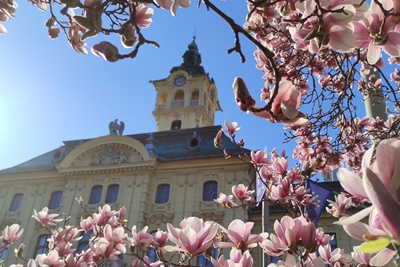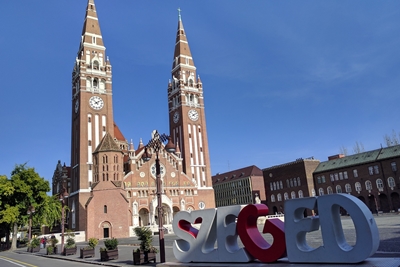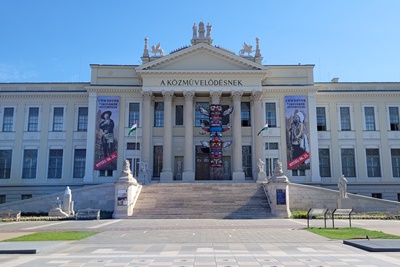Discover the rich architectural heritage of Szeged, much of which can be easily reached on foot from our hotel.
Votive church![]()
Address: 6720 Szeged, Dóm tér 16.
After the great flood of 1879, the city vowed to build a monumental church in honour of the Virgin Mary to commemorate the rebuilding of Szeged and to save it from further floods. That is why the Dome is called the Votive Church.
The plans were made by Frigyes Schulek. The church was consecrated on 24 October 1930. The Dome is the most monumental work of 20th century church architecture.
The cathedral was built in neo-Romanesque style, its interior decoration is in the early Christian Byzantine style. The decorative painting was done under the supervision of Ernő Foerk.
When it was built, the Dome's famous organ was the third largest of its kind in Europe. It has 9,740 pipes and 134 different pitches. The largest pipe is 5 metres long, the smallest 1.5 centimetres. Its pipes are located in the choir, in the dome and on both sides of the sanctuary.
Dömötör tower![]()
Address: 6720 Szeged, Dóm tér 16.
Dömötör Tower, the oldest building in Szeged, the only surviving tower of the parish church of St Demeter, which stood on the site of the present-day Dome Church, is the oldest building of Szeged, dating back to the 11th century. The church was first mentioned in 1199. It was rebuilt several times, and it was not until the 18th century that it reached its final form.
After the devastation of the Great Tisza Flood, the church, which had suffered many tragedies, was demolished 46 years later, in 1925, to be replaced by the new symbol of the city, the Church of the Assumption designed by Ernő Foerk, the now famous Szeged Dome.
The Dömötör Tower was built into the walls of the St Demeter Church and was discovered during its demolition. In 1931 it was renovated and turned into a baptistery.
Black house
Address: 6720 Szeged, Somogyi utca 13.
The building on the corner of Somogyi-Kelemen street is located almost opposite our hotel. It was built in 1857 in the English romantic style, designed by Károly Gerster.
The building, originally a merchant-civic house and later a casino, takes its name from its former dark grey and black plaster. For many decades, the Black House has been the permanent exhibition space of the History Department of the Ferenc Móra Museum, and regularly hosts temporary exhibitions related to the town's past.
The intersection where Black house stands is unique in Szeged, as all four of the buildings on its corners were built in the mid-19th century, survived the flooding and are protected as monuments of historic interest.
Móra Ferenc Museum![]()
Address: 6720 Szeged, Roosevelt tér 1-3.
The most impressive building in Szeged during the millennium building frenzy is the Neoclassical-style Palace of Public Culture, built in 1896.
The building was constructed for the city museum and the Somogyi library, and during Ferenc Móra's directorship (1917-34) the range of exhibitions was expanded. Nowadays, permanent exhibitions of ethnography, natural history, fine arts and many large-scale temporary exhibitions are held in Szeged and its surroundings.
From the two lookouts on the roof of the Móra Ferenc Museum you can see the city centre of Szeged from a high viewpoint, the smaller one overlooking Széchenyi Square and the larger one overlooking the Tisza and the "Belvárosi" Bridge. In the larger one, a special device, a chronoscope, is waiting for you. Looking into it, you can see the city centre of Szeged in the 1870s.
Anna bath![]()
Address:6720 Szeged, Tisza Lajos körút 24.
Anna bath is a white-walled eclectic building with oriental influences along Tisza Lajos körút. It was built in 1896 according to the plans of Antal Steinhardt and Adolf Lang. It was originally a public baths in the town. It takes its name from the well drilled next to it in 1927 and its water.
The daughter of Dezső Patzauer Patzauer, the first entrepreneur to bottle the medicinal water, was named Anna, and the spa is dedicated to her memory. The water can be used as a drinking fountain for digestive ailments, and the people of Szeged regularly take it home from the Anna well.
The spa offers spa treatments and wellness services, and on certain days there is also the possibility to relax with a night bath.
New Synagogue![]()
Address: 6722 Szeged, Jósika u. 10.
The construction of the new synagogue and community centre started in August 1900 and was completed by October 1902. In addition to the Moorish Art Nouveau style, the monumental 48.5 metre high building has a Byzantine influence with the insertion of a baroque-looking dome with scrolls.
The glass windows, made in the workshop of Mano Roth, and the symbolic glass dome of unparalleled beauty are unique jewels of the eclectic synagogue.
The interior is dominated by an eye-catching harmony of ivory, gold and blue decorations. The altar's Jerusalem marble keystone, the Nile acacia wood door of the nave, the semi-precious stone menorahs and the murals of biblical plants are all notable.
The synagogue, with its excellent acoustics, is a special venue for organ and valuable light music concerts.
Szent István Square Water Tower![]()
Address: 6720 Szeged, Szent István tér
The country's first reinforced concrete water tower welcomes visitors to Szent István Square. The tower, with a capacity of 1004.8 m3 of water, was built in 1904 and still serves its original function. It was built entirely of reinforced concrete, with no exceptions such as the entrance door and the flagpole.
The tower, which was renovated in 2006, has a Foucault ring inside, which proves that the Earth rotates on its axis.
The water tower was originally built with a viewing platform, and since its renovation it has been open to the public during the summer and occasional open days. The tower houses two permanent exhibitions: a collection of rock water production on the ground floor and an exhibition on the history of physics on level VII. On level II you can see the original plans of the tower and the renovation, as well as photographs of the renovated water tower.
City Hall
Address: 6720 Szeged, Széchenyi tér 10.
The present City Hall is the third building on the same site with the same function.
The first building, of modest design, was built in 1728, and the second one was built on the site of the first one at the turn of the 18th and 19th centuries, on the present site.
After the floods that almost completely destroyed the town (1879), the square was filled in, making the building too small and clumsy. Ödön Lechner and Gyula Pártos designed a new storey and a slender central tower on the existing foundations.
The neo-Baroque City Hall was inaugurated in 1883 by Franz Joseph I. The central window of the staircase is decorated with the famous saying of the King: "Szeged will be more beautiful than it was before". The Bridge of Sighs, originally built for the King and his entourage visiting the rebuilt city, is also worth a visit.
In the summer, music and theatre programmes await the public in the unique courtyard of the Town Hall.





